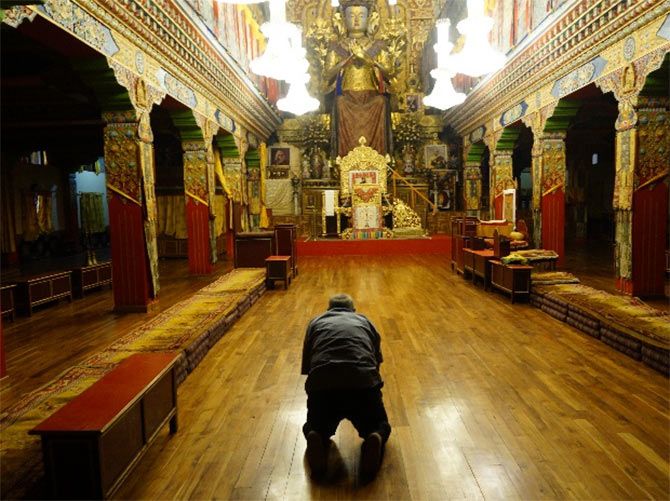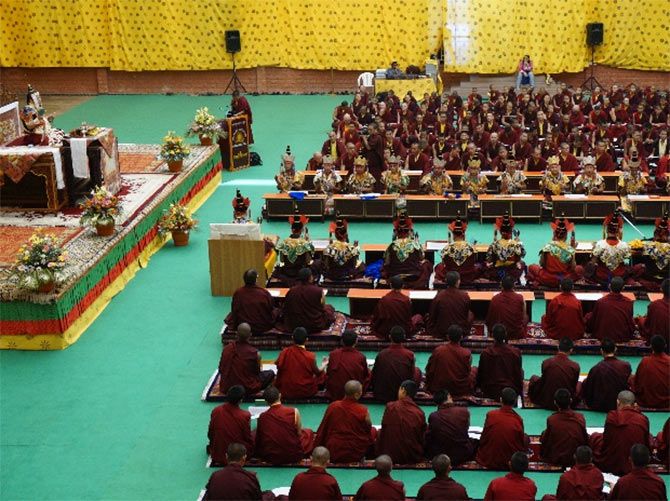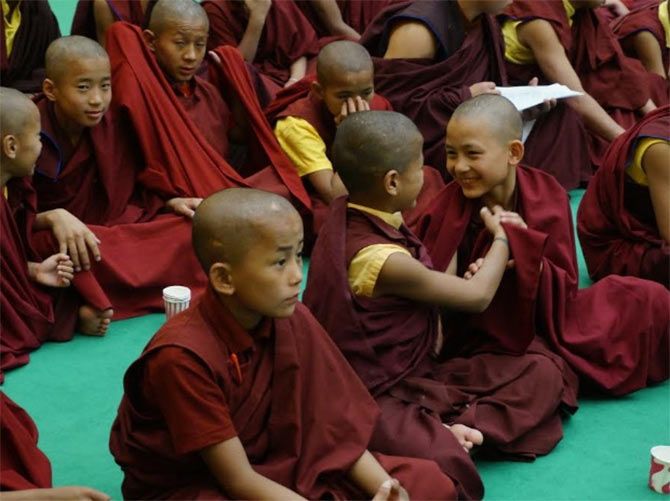A visit to the Palpung Sherabling Monastery where monks are free to choose their own paths.
One reaches the Palpung Sherabling Monastic Seat, tucked away in the Dhauladhar ranges, after negotiating the sharp bends through Palampur and Baijnath. Once there, the feeling of stepping into a foreign land is unmistakable.
The monastery overlooks the golden pagodas with colourful windows, and an uncanny mysticism surrounds the place. Tibet seems to be just a stone’s throw away.
The road to Palpung is busy and dotted with temples and eateries. However, in an effort to stop Palpung from turning into another commercial tourist spot, the area has been kept free of shopping centres and pigeon-hole hotels, unlike Dharamshala or McLeodganj. And that makes Palpung serene and blissful.
The place is located atop a hill and overlooks majestic mountains. There is a guest house run by the monastery where monks cook vegetarian food. For non-vegetarians, there is the Tibetan colony that can be accessed by car.

The Palpung Sherabling Monastic Seat was established by the 12th Kenting Tai Situpa Pema Dönyö Nyinje. The Tai Situpas are regarded as the incarnations of The Great Marpa, who was born in 1012, and observe the Kagyu school of Tibetan Buddhism.
Born to a family of farmers in Kham, the 12th Tai Situpa ascended to the seat when he was all of 18 months. Once the Tibetan conflict began, he was forced to flee his country. Thereafter, he obtained education in Sikkim where he was given religious training by the 16th Karmapa.
The monastery has been personally designed by the 12th Tai Situpa who was also instrumental in developing the surroundings that include a guest house adjacent to a quintessential Tibetan village called the Bir Tibetan Colony, a hamlet that came up in the 1960s.
The colony is sprinkled with momo stalls and cafés to cater to the paragliders who come to nearby Bir-Billing, famous for adventure sport.
The Tai Situpa lineage of Buddhism follows the tradition of teacher and disciple. As a result, unlike other monasteries, one sees a much affable relationship between teacher and disciples here.

The 12th Tai Situpa has given the liberty to all his disciples to follow their hobbies and travel around the world. Theirs is not a closed society.
Thus, the monks of Palpung Sherabling Monastery received the Grammy Award for Best Traditional Music Album for Sacred Tibetan Chant in 2004.
Maintenance of the monastery remains a big challenge that looks more like a palace complex rather than a spiritual centre. According to the Tai Situpa, the funds are donated by all his disciples, comprising mostly of foreigners or NRIs. “All the money comes from the disciples.
The government has given us the same help as they have given to all of free Tibet,” the Tai Situpa tells me.
He also believes that the Buddha is not confined in just one form or character and that he is still alive and amidst us. The one who passed away in Kushinagar in 483 BC was Prince Siddhartha and not the Buddha.

The 12th Chamgon Kenting Tai Situpa, who belongs to the Vajrayana sect of Buddhism, is often invited by dharma centres worldwide where he interacts with people from various others schools of Buddhism: Zen, Theravada and Mahayana.
He has established learning and spiritual institutes in Hawaii, San Francisco and Paris. He is also known for his mastery in artistic works, poetry, writing and compilation of Buddhist texts.
During Buddha Purnima every year, the monastery decks up like a queen. The town turns colourful, reflecting the bright hues of tourists’ attires amid the maroon robes of the monks. The place reverberates with chants. Occasionally, one hears loud applause coupled with shrieking sounds, only to realise that the monks are having a debate on current affairs and religious issues.

The monastery is famous for giving shelter to several poor children who then acquire religious education and teaching here. However, once they become monks they are free to choose their paths.
Under the Tai Situpa, several monks have been recognised as Rinpoches who have gone on to set up their own spiritual centres. There are many who hail from affluent families but have chosen to become monks.
Some monks have also moved on and settled into family life. However, they continue to spread the teachings and encourage others to follow the discipline. For them, practising their faith does not translate into relinquishing freedom.
One such monk is Dipnkar Khanna, who is now based in Bengaluru with his wife and two daughters and works as a teacher, author, painter and photographer.
“I remember having my first encounter with the Dalai Lama in 1989 when he encouraged me to study Buddhism. Since then, I have learned and practised advanced mind development techniques, first at the Library of Tibetan Works and Archives and later at Sherabling Institute of Buddhist Studies under the tutelage of the 12th Kenting Tai Situpa and other senior Lama’s, both as a lay disciple and later as a monk in the Tibetan Buddhist Order,” Khanna discloses.
Khanna has already penned down his first book, Mind Warriors – Winning Strategies with NLP. He is working on his second book on Buddhism. He is still in touch with the monastery and continues to carry out several of their outreach programmes.
The Tai Situpa also visits him once a year in Bengaluru to meet many of his disciples there. This unmatched permissive teacher-disciple relationship is what makes Palpung Sherabling monastery out of the ordinary.











